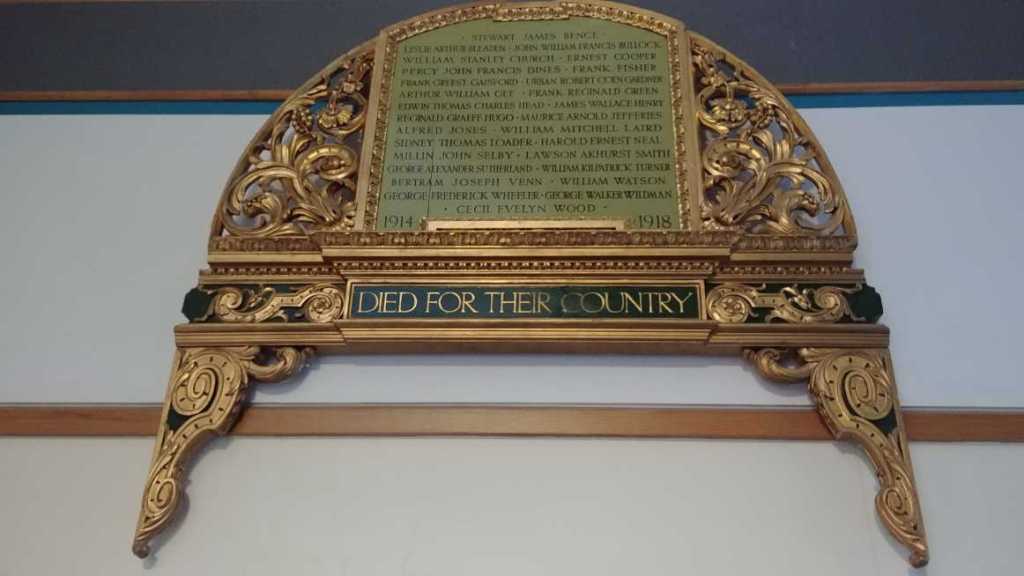- See William Kilpatrick Turner’s entry on the Board of Trade’s Ancestry public tree.
- This information updates the group’s previous research published on the former DTI website (now archived by the National Archives).
- Do you have any more information about William Kilpatrick Turner? If so the War Memorial Research Group would love to hear from you.
Name recorded on Board of Trade Memorial: W. K. Turner
Born: About February 1899 in Glasgow, Scotland
Date of Death: 28 June 1918
Age at death: 19
Service, Regiment, Corps, etc: Royal Scots (Lothian Regiment)
Unit, Ship, etc: “D” Company, 12th (Service) Battalion
Enlisted: Deptford, London
Rank: Private (Service no. 51297 and formerly 2/17920)
Decorations: WW1 Service Medals (British War Medal and Victory Medal)
War (and theatre): WW1 (France and Flanders)
Manner of Death: Killed in Action
Family Details: Son of Mr and Mrs Thomas Turner of Springburn, Glasgow
Residence: 55 Upper Brockley Road, London
Home Department: Board of Trade – Patents Office
Civilian Rank: Boy Clerk
Cemetery or Memorial: La Kreule Military Cemetery, Hazebrouck, France (II.C.I) ; Board of Trade War Memorial; Patent Office Memorial 1914-1918 (located at Concept House, Newport, Wales); Cadder Cemetery, Bishopbriggs, East Dunbartonshire, Scotland ; Scottish National War Memorial, Edinburgh, Scotland; Glasgow WW1 Roll of Honour; Glasgow Cenotaph;
Biography:
During WW1, Glasgow paid a heavy price. Over 200,000 men from the city (who accounted for a fifth of whole city population) served in the military. Of these men, around 18000 were killed and 35000 men were injured. William Kilpatrick Turner was one of that number.
William was born in about February 1899 in Glasgow. His father was Thomas Turner (1869-) and his mother was Agnes Kilpatrick (1874-). He had an older brother called Thomas (1898-) and a younger sister called Agnes McIver Turner.
In the 1901 census, William is recorded aged 2 living with his parents and brother at 65 Avenue Road, Springburn, Glasgow. His father was a rail engine maker/fitter.
William moved to London to work for the Civil Service as a Boy Clerk at the Patent Office which then located at Chancery Lane.
According to his surviving WW1 Service Record which details the date of his attestation for war service on 13 January 1917, William was living at the time at 55 Upper Brockley Road, London aged 17 years and 11 months.
We haven’t yet found a photo of William, but we know from the description in his service record that was 5 foot 4 and three quarters and weighed 118 pounds. He is described as having a brown mark on his top left shoulder and a scar on his left cheek.
William was posted to the Army Training Reserve. He was mobilised on 4 April 1917 and posted to serve as a Private in the 56th Battalion of the Cameronians (Scottish Rifles) Regiment. The Cameronians were a territorial unit recruited from men who mostly lived and worked in and around Glasgow.
On 30 June 1917 he was transferred to the 79th Battalion, Cameronians (Scottish Rifles). He was transferred again on 5 December 1917 to the 3rd Battalion, Scottish Rifles. Then on 27 March 1918 he was transferred to the Royal Scots Regiment which was the oldest and most senior infantry regiment in the British Army. William must have been proud to join this particular regiment with its long history.

In 1918 the Royal Scots fought at the Somme in the Battle of the Lys (April 1918) and the advance in Flanders.
William was killed in action and died aged 19 years old on 28 June 1918. At the time of his death he was serving with the 12th Battalion, Royal Scots (Lothian Regiment). He was one of 11000 soldiers serving with the regiment who were killed in WW1.

William is buried at La Kreule Cemetery which is located in a small hamlet just north of Hazebrouck in France where there are 576 WW1 Commonwealth soldiers buried and also 11 German war graves. The cemetery was initially opened in April 1918 by the 1st and 2nd Australian Casuatly Clearing Stations ahead of the German advance.
His gravestone bears the personal inscription “Son of Mr & Mrs Turner 212 Hillhouse Gardens Springburn Sadly Missed”
William is also named on his family gravestone at Bishopbriggs, East Dunbartonshire, Scotland. He is also remembered by two Civil Service War Memorials – the Board of Trade War Memorial located in London and the Patent Office War Memorial now located in Newport, Wales


William is remembered by the Scottish National War Memorial which commemorates the lives of nearly 135,000 Scottish casualties during WW1 as well many subsequent conflicts. The memorial is located at Crown Square at Edinburgh Castle and a peaceful Hall of Honour and Shrine was built in 1927 by Sir Robert Lorimer and 200 Scottish artists and craftspeople. It is here that the Rolls of Honour are kept on permanent display.


Across the whole of Scotland around 148,000 men were killed and more than 18,000 are named on the Glasgow Roll of Honour, which was first published in 1922. William’s name appears in this commemorative publication, which is stored in the City Chambers, George Square and also in The Mitchell Library, Glasgow. George Square is also the location of the Glasgow Cenotaph or War Memorial which was unveiled by Field Marshal Douglas Haig, 1st Earl Haig in 1924.

